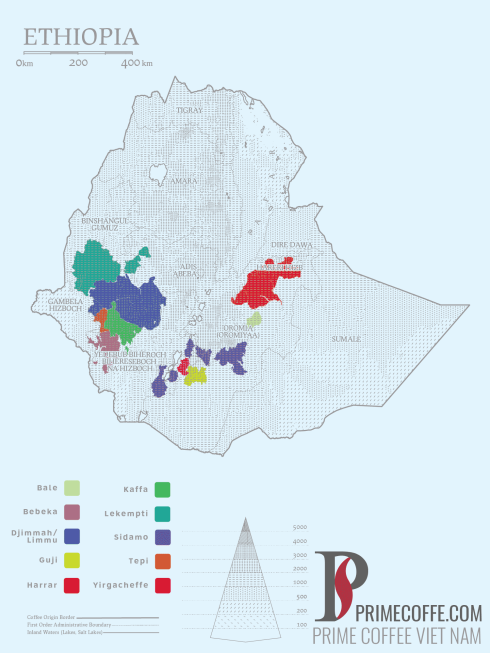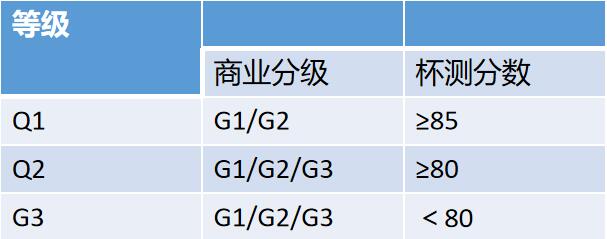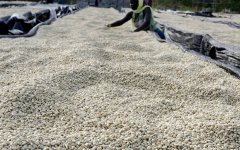Coffee producing country Ethiopia | what is the grade standard of fine coffee beans G1 Q1 and its new rules
Ethiopia has always been a big coffee country, where thousands of coffee trees are planted. She is not only the treasure of coffee, but also the moonlight in the hearts of many coffee lovers.
With regard to the grading of raw beans in Ethiopia, let's study the following:

The grading of the Ethiopian Coffee Bureau is based on two criteria: cup test and raw bean quality:
First, cup test quality: according to the cleanliness of raw beans, the characteristics of producing areas, cup test flavor, the characteristics of the beans.
Second, the quality of raw beans: in addition to measuring the taste of the cup, it should also be graded according to the shortcomings of the sampled raw beans. 300 grams of raw beans were randomly selected for testing, and classified according to the number of defects calculated by sampling, Ethiopian coffee was divided into 9 grades: high-quality grades were G1 and G2, and the other grades were G3murG9 and G6, which were only limited to the domestic market.


After the establishment of the Ethiopian Commodity Exchange, there are two levels of Q1 and Q2 for fine beans. Bean hunters in Ethiopia do not rely on the official levels of Q1 or Q2, but mainly rely on the actual cup test quality results, supplemented by the inspection of raw beans.
The new system of Ethiopia Commodity Exchange:
In 2008, with the assistance of the United States Agency for International Development, Ethiopia established a state-run commodity exchange, which aims to make transactions transparent and give farmers a reasonable income. it also makes the government aware of market flows and controls Ethiopia's most important foreign exchange earnings. Ethiopia is almost dominated by a small-scale peasant economy, and trading stations have been set up in the main producing areas of the country so that both prices and transactions can be guaranteed by the state. According to regulations, coffee transactions across the country must go through exchanges, and only a very small number of private farms or production cooperatives can trade directly with foreign buyers.
Despite good intentions, many of the rules of the Ethiopian Mercantile Exchange run counter to the logic of international boutique buyers. For example, the Ethiopian Commodity Exchange believes that raw beans from the same production area and the same grade should be substitutable, and that there should be no difference between the batches harvested earlier in December and those in February of the following year. As long as the appearance and shortcomings of raw beans belong to the same grade and the same legal marked producing area, they will be classified as coffee of the same grade, and the flavor characteristics of different batches are not taken into account in this grading method.
Ethiopia has always been a big coffee country, where thousands of coffee trees are planted. She is not only the treasure of coffee, but also the moonlight in the hearts of many coffee lovers.
With regard to the grading of raw beans in Ethiopia, let's study the following:
The grading of the Ethiopian Coffee Bureau is based on two criteria: cup test and raw bean quality:
First, cup test quality: according to the cleanliness of raw beans, the characteristics of producing areas, cup test flavor, the characteristics of the beans.
Second, the quality of raw beans: in addition to measuring the taste of the cup, it should also be graded according to the shortcomings of the sampled raw beans. 300 grams of raw beans were randomly selected for testing, and classified according to the number of defects calculated by sampling, Ethiopian coffee was divided into 9 grades: high-quality grades were G1 and G2, and the other grades were G3murG9 and G6, which were only limited to the domestic market.
After the establishment of the Ethiopian Commodity Exchange, there are two levels of Q1 and Q2 for fine beans. Bean hunters in Ethiopia do not rely on the official levels of Q1 or Q2, but mainly rely on the actual cup test quality results, supplemented by the inspection of raw beans.
The new system of Ethiopia Commodity Exchange:
In 2008, with the assistance of the United States Agency for International Development, Ethiopia established a state-run commodity exchange, which aims to make transactions transparent and give farmers a reasonable income. it also makes the government aware of market flows and controls Ethiopia's most important foreign exchange earnings. Ethiopia is almost dominated by a small-scale peasant economy, and trading stations have been set up in the main producing areas of the country so that both prices and transactions can be guaranteed by the state. According to regulations, coffee transactions across the country must go through exchanges, and only a very small number of private farms or production cooperatives can trade directly with foreign buyers.
Despite good intentions, many of the rules of the Ethiopian Mercantile Exchange run counter to the logic of international boutique buyers. For example, the Ethiopian Commodity Exchange believes that raw beans from the same production area and the same grade should be substitutable, and that there should be no difference between the batches harvested earlier in December and those in February of the following year. As long as the appearance and shortcomings of raw beans belong to the same grade and the same legal marked producing area, they will be classified as coffee of the same grade, and the flavor characteristics of different batches are not taken into account in this grading method.
Important Notice :
前街咖啡 FrontStreet Coffee has moved to new addredd:
FrontStreet Coffee Address: 315,Donghua East Road,GuangZhou
Tel:020 38364473
- Prev

Different methods of washing and drying honey in Rose Xia Village | Red Standard Gold Standard Coffee beans in Rose Xia Village have a special flavor and taste.
What kind of coffee can be rich in layers and perfectly match the aroma of flowers and fruit? Let's take a look at the brief introduction of this bean: batch GVA.RSV.1a:Oma Gesha 1931 description: fermented honey this batch of coffee is produced by mossto anaerobic fermentation in cooperation with friends of Santuario Project in Colombia. Pulp coffee beans are in the fresh juice of compressed coffee beans.
- Next

Impact of Ethiopian Commodity Trading Exchange ECX on Coffee Export quality | Coffee bean value chain
The coffee atmosphere in Ethiopia is very strong. His unique geographical environment and climatic conditions make the coffee taste wonderful. Rich, the depth, width and breadth of the flavor are among the best. As the oldest coffee drinker, how did Ethiopia grow into a huge coffee empire? This is closely related to the Ethiopian Commodity Exchange, Ethiopia in 2008.
Related
- Detailed explanation of Jadeite planting Land in Panamanian Jadeite Manor introduction to the grading system of Jadeite competitive bidding, Red bid, Green bid and Rose Summer
- Story of Coffee planting in Brenka region of Costa Rica Stonehenge Manor anaerobic heavy honey treatment of flavor mouth
- What's on the barrel of Blue Mountain Coffee beans?
- Can American coffee also pull flowers? How to use hot American style to pull out a good-looking pattern?
- Can you make a cold extract with coffee beans? What is the right proportion for cold-extracted coffee formula?
- Indonesian PWN Gold Mandrine Coffee Origin Features Flavor How to Chong? Mandolin coffee is American.
- A brief introduction to the flavor characteristics of Brazilian yellow bourbon coffee beans
- What is the effect of different water quality on the flavor of cold-extracted coffee? What kind of water is best for brewing coffee?
- Why do you think of Rose Summer whenever you mention Panamanian coffee?
- Introduction to the characteristics of authentic blue mountain coffee bean producing areas? What is the CIB Coffee Authority in Jamaica?

